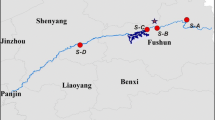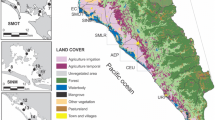Abstract
An account is given of the use of Enteromorpha to monitor zinc, cadmium, mercury and lead pollution in six estuaries and the British North Sea coast. The ranges for each element were: Zn, 19–437 µg g−1; µg g−1 Cd, 0.07–4.8 µg g−1; Hg, 0.02–0.23 µg g−1. It is suggested that tissue analysis of Enteromorpha is one of the most useful biological techniques available in estuaries for pin-pointing aqueous (as opposed to sediment) metal contamination, and also for providing data suitable for world-wide comparisons. Provisional values are given for concentrations corresponding to ‘moderate’ and ‘high’ pollution.
Similar content being viewed by others
References
Bryan, G. W., W. J. Langston, L. G. Hummerstone & G. R. Burt, 1985. A Guide to the Assessment of Heavy Metal Contamination in Estuaries Using Biological Indicators. Occ. Publs mar. biol. Ass. U.K., No. 4, 92 pp.
Harding, J. P. C., 1980. Concentrations of Metals in Plant Samples from the Mersey Estuary November 1979–February 1980. North West Water Authority, Rivers Division, Technical Report TS-BS-80-5, 42 pp.
Harding, J. P. C., 1982. Use of Enteromorpha as a Monitor of Heavy Metal Contamination in the Mersey Estuary November 1979–1980. North West Water Authority, Rivers Division, Technical Report TS-BS-82-5, 35 pp.
Jeffrey, D. W., 1988. Biomonitoring of freshwaters, estuaries and shallow seas: a commentary on requirements for environmental quality. In: M. Yasuno & B. A. Whitton (Eds), Biological Monitoring of the Environmental Pollution. Tokai University Press: 75–90.
Levine, H. G., 1983. The use of seaweeds for monitoring coastal waters. In: L. E. Shubert (ED.) Algae as Ecological Indicators. Academic Press, New York: 199–210.
Phillips, D. J. H., 1977. The use of biological indicator organisms to monitor trace metal pollution in marine and estuarine environments — a review. Envir. Pollut. 13: 281–317.
Phillips, D. J. H., 1980. Quantitative Aquatic Biological Indicators. Applied Science Publishers, London, 487 pp
Say, P. J., I. G. Burrows & B. A. Whitton, 1986. Enteromorpha as a monitor of heavy metals in estuarine and coastal intertidal waters. Occ. Publs No 1, Northern Environmental Consultants Ltd, 28 pp.
Seeliger, U. & C. Cordazzo, 1982. Field and experimental evaluation of Enteromorpha sp. as a quali-quantitative monitoring organism for copper and mercury in estuaries. Envir. Pollut. A29: 197–206.
Seeliger, U. & R. Knak, 1982. Estuarine metal monitoring in tropical Brazilian estuaries. In: U. Seeliger, L. D. de Lacerda & S. R. Patchineelam (Eds) Metals in Coastal Environments of Latin America. Springer-Verlag: 258–269.
Wehr, J. D., P. J. Say & B. A. Whitton, 1981. Heavy metals in an industrially polluted river, the Team. In: P. J. Say & B. A. Whitton (Eds). Heavy Metals in Northern England. Environmental and Biological Aspects. Department of Botany, University of Durham: 99–107.
Wilkinson, M., 1981. Survival strategies of attached algae in estuaries. In: N. V. Jones & W. J. Wilff (Eds). Feeding and Survival Strategies of Estuarine Organisms. Plenum Press, N.Y.: 17–29.
Author information
Authors and Affiliations
Additional information
Deceased




